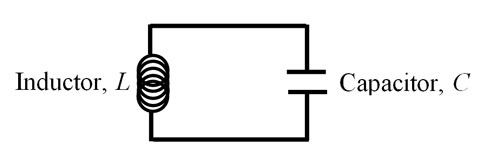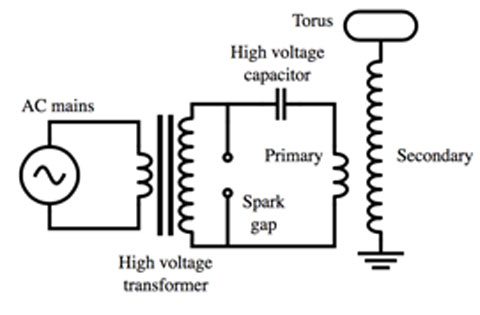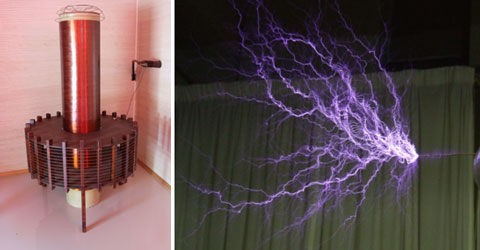Electrifying Tesla Coil Music and Fashion
September 8, 2014
At the May 2014 Bay Area Maker Faire, the high-tech fashion designer Anouk Wipprecht and music-makers ArcAttack joined forces for an electrifying show based on Tesla coils. Take a look at the video below to see the action!
This performance likely raises several questions for Tesla coil initiates: Why isn’t the “lightning” affecting the person it is striking? How do you make music with Tesla coils? What exactly is a Tesla coil?
Fields, Tesla, and Basic Transformers
Tesla coils are basically special types of transformers — apparatuses that rely on magnetic induction, which, in turn, is based on the interaction between electric and magnetic fields.
Electric fields and magnetic fields act at a distance (like gravity) and interact with each other. A changing magnetic field pushes or pulls charged particles, and if those charges are free to move (like in a conducting material), an electric current arises. Electric current entails that electric charges are moving, and this movement creates a magnetic field. This process of creating an electric current and magnetic field is called induction.1
When a changing magnetic field points perpendicularly through a closed loop of conducting wire, it generates an electric current in the wire. In turn, the moving charges will produce another magnetic field. This bit of fundamental physics underlies motors, generators, transformers, and inductors.
Alternating currents (AC) are currents that change in time by going one direction and then the other, producing a magnetic field that changes in time. Direct currents (DC) are currents that only travel in one direction.
Long ago, when transmission of electricity to homes was first an issue, Thomas Edison, was delivering direct current. He was given a letter of recommendation to hire Nikola Tesla. Edison did not like Tesla’s idea of alternating current, but hired Tesla to improve his direct current delivery methods and, as the story goes, Edison offered a good amount of money to do so.2
After Tesla succeeded in increasing the efficiency of electricity via direct current, Edison did not pay Tesla and said the money offer was part of a joke that Tesla did not understand.2 Tesla left Edison’s company and the famous “war of the currents” began.
Tesla ventured out on his own, and after a year of hard labor, began his own company. He developed an AC generator and motor. Eventually George Westinghouse became interested in his AC delivery devices and the two joined efforts and made a bid to light up the 1893 World Fair.2 They were highly successful! Soon Tesla’s works were being utilized to harness energy from Niagara Falls and deliver AC current throughout the region.
Nikola Tesla also worked on wireless transmission devices with the unrealized goal of transmitting electricity across the Atlantic Ocean wirelessly (although he was able to wirelessly control a model ship). He also lit a gas discharge lamp in his hand using high voltage and high frequency alternating current. And the fundamental physics behind all of this has to do with the interactions between electric and magnetic fields: a changing magnetic field induces an electric current and an electric current induces a magnetic field.
Basic transformers are made of a helical coil of wire (like a spring) through which an alternating current travels. When this coiled wire is brought near another coil of wire, the changing magnetic field produced by the first coil induces an electric current and magnetic field in the second coil.
The coils of wire do not need to be touching each other because electric and magnetic fields act at a distance. However, the strength of these fields are proportionally stronger at closer distances: the closer they are, the larger the effect.
The amount of the primary (first) coil’s field that interacts with the secondary (second) coil defines how coupled the two coils are. Common transformers couple 97 percent or more of the magnetic field and are low energy loss.1
Common transformers, like the one in the diagram below, rely on magnetic induction to increase or decrease voltage. The primary coil of wire carries an alternating current that creates a changing magnetic field. This changing magnetic field (described by the magnetic flux in the diagram) induces a current in the secondary coil.
Transformers are typically seen on electric lines, and are used to decrease the voltage supplied from power plants’ buildings. Transformers are also commonly used with cell phone charging cables, laptop computer charging cords, and printers. The transformers for these devices are located in the large area of the cord that plugs into the wall.1

From Left to Right: (A) A Graphic of a transformer, showing coiled primary wire and coiled secondary wire. Often an iron core is placed in the windings to increase the amount of magnetic field lines that go through the secondary windings; (B) a common polemount transformer; (C) and a disassembled AC adapter.
Image Credits: A. Daniels, Glogger, and Cuddlyable3, respectively (all via Wikimedia Commons).
Tesla Coils
Tesla coils are transformers, but they aren’t the common transformer. They rely on the same fundamental physics, but Tesla transformers differentiate themselves in a variety of ways. Tesla transformers operate under very high voltages, high frequencies, and low currents — conditions that would destroy many common transformers.
Tesla transformers have a primary coil with just a few windings, and a secondary coil with many, many windings. Between them is just air, and they only couple about 10 percent to 20 percent of the induced magnetic field.3 These coils are each connected to their own capacitor, making each of them a resonant circuit, and they are designed to be resonant with each other.
A resonant circuit is one that cycles through periodically having a current and then no current. First, consider a small capacitor, which is two metal plates very close to each other but not touching.
If we connect a capacitor to a battery, as soon as we close the circuit, charge will begin to flow around the circuit, with electrons piling up on one plate of the capacitor, and being pushed off of the second plate of the capacitor because they feel a push from the distant charge pushing them from the first plate, and a pull toward the positive terminal of the battery.
The current (flow of charge) in the circuit continues until the plates are filled with the maximum charge the capacitor can hold. Remember, like charges repel, so as each charge gets stuck on the first plate, it becomes more difficult to put another charge on it.
This fully charged capacitor connected to the battery has two options: Not too strong battery leads, current in circuit stops because plates are full, everything remains the same; or too strong batter, more charge gets pushed onto full plates causing charge to jump across gap between the two plates and ionize the air between them.

An example circuit with a capacitor.
If we take a fully charged plate and remove it from the battery and connect it to a loop of wire (inductor), what will occur (if there are no losses) is a swinging back and forth of the energy from the capacitor to the inductor.
As the charged capacitor tries to discharge, allowing the negative charges on one side of the plate to travel through the wire to the other side of the capacitor, the charges feel a force in the opposite direction due to an induced current set up in the coil of wire, and this occurs until the plates are discharged, and then the inductor, due to the decreasing current as the other plate fills, has an induced current that continues charging the capacitor plate until what was once the positively charged plate becomes a negatively charged plate with maximum charge –Q.

An example circuit with both an inductor and a capacitor.
In this way, the circuit swings the charge back and forth, and the current back and forth. If there were no losses, this would continue forever, but there are losses, and eventually the energy is dissipated away to heating the wires and the environment.
In the Tesla coil, the energy in the primary coil and capacitor flows back and forth through many cycles. The secondary coil and secondary capacitor has the same cycling of energy so it is resonant (swings with the same frequency) with the primary coil and capacitor. The primary coil transfers its energy to the secondary coil over a number of cycles until all of the energy is transferred out of the primary to the secondary or to losses.
Because the primary and secondary coils are swinging together (resonant), Tesla coils are pretty efficient, with 85 percent or more energy transferred from primary to secondary,3 even though the field coupling is very small.
For the primary coil, electric charge first has to completely fill a special capacitor that acts like a switch (spark gap) that sends current to the primary coil and primary capacitor, and the cycling begins. The cycling is at a high frequency (between 20 and 100 thousand times per second).
This then induces a magnetic field, which induces a current in the secondary coil. The secondary coil has many windings, but is far enough away from the primary coil that it is insulated from it, and hence does not break down.
The number of windings of the secondary coil, and the capacitance at the top, are based on the resonant frequency in the primary coil. Tesla coils require that the resonant frequency of the secondary coil is equal to that of the primary coil.
Because there are so many more windings on the secondary coil, the secondary capacitor has a much lower capacitance, but it is capable of carrying much more charge and a much higher voltage because of its toroidal/doughnut-like geometry. The induced current in the secondary coil then charges the secondary capacitor attached to the secondary coil.

A schematic of a Tesla coil. The High voltage capacitor is the primary capacitor. The torus is the secondary capacitor which holds a very high charge and has a very low capacitance.
Image Credit: Omegatron via Wikimedia Commons.
The photograph below depicts a Tesla transformer in the Nikola Tesla Memorial in Croatia. The bottom part is a short coil of very “loose” windings connected to a capacitor. The inner core is the secondary coil with many, many windings. Air resides between the two coils and inside both coils.
The top of the inner coil has a “cage” over it that acts to collect the charge (the secondary capacitor). Because of the top’s large radius of curvature and surface area, it is able to collect a large charge and support high voltages before it discharges into the air. When it does discharge, it ionizes the air like bolts of lightning.

From Left to Right: A Tesla coil; A Tesla coil discharge seen at the 2006 UK Teslathon in Derby. Image Credits: Zátonyi Sándor and Caroline Tesman, respectively (both via Wikimedia Commons).
Musical Coils
Editor's Note: An earlier version of this section gave an incomplete explanation of ArcAttack's method of producing music. The section has since been updated and corrected.
The band ArcAttack4 makes creative use of modern Tesla coil discharges to make music. Modern Tesla coils use solid state circuitry that wasn’t available to Tesla.
The band also modifies their Tesla coils because the traditional coils can cause electromagnetic interference that often causes damage to nearby electronics if the current during the discharge is too high (This was a problem Tesla often had with his neighbors). To reduce the current, and the effect of the electromagnetic interference, ArcAttack adds another inductor (coil of wire) to regulate the rate at which the top capacitor discharges.
The discharges also can go anywhere in the environment, but they are most likely to strike the most conductive object nearby. Metals are good conductors, so ArcAttack puts window screening on the ground and metal fences nearby to contain the discharges.
So how does the band translate electricity into music? Musical notes are created by making a sound at a specific frequency which determines a note’s pitch. For example middle C (C4) has a frequency of 261.6 Hz or 261.6 cycles per second, and the note A4 has a frequency of 440 Hz or 440 cycles per second. To create the note A4, an air pressure disturbance would need to be produced about once every 0.00227 seconds (1/440 cycles per second).
This is not the same frequency as the resonant frequency of the primary and secondary coil used to ramp up the voltage from the 300 to 600 volts they input into the coils to the 0.5 million volts they produce with the coils. The resonant frequency between the primary and secondary coils is about 40 kHz according to the video interview with ArcAttack, embedded below. This is way too high of a frequency for our ears to detect.
But a sound is heard when the top capacitor discharges, ionizes the air, and creates some bolts of light. By causing their Tesla coils to discharge at the same frequency as a note, ArcAttack is able to create that note.
To create a note out of this sound, ArcAttack controls the on/off switch of the Tesla coils using fiber optic cables that send a signal to turn on and off a microcontroller. They turn on the coil for 100 to 500 microseconds (millionths of a second), depending on the note they want to create: longer on durations for lower notes and shorter durations for higher notes. During this time, the secondary coil goes through 15 to 16 cycles; the coils are then turned off, and the tesla coils arc and make a pop.
If they do this 440 times per second, making a popping sound each time, the sound would be repeated at the same frequency or pitch as the note A4, and our ears would hear that note. 440 cycles per second for the sound wave means that we hear a pop approximately every 2.27 milliseconds.
During the the time that the Tesla coils are on, they are resonating at 40,000 cycles per second and the secondary coil and capacitor goes through about 15 or 16 cycles of storing energy on the toroidal capacitor, and the arcs grow from cycle to cycle.
ArcAttack composes their music with their technology in mind. They have to program their circuitry to cycle on and off at various notes, for various durations of time, and with an electrifying light show to match the music. They have a robotic drummer to keep the entire band in time.
Below is a video interview with ArcAttack (about 17 minutes) in which they explain their Tesla coils, including how they build them, and how they make music with them. The video also includes some cool demonstrations (like turning a piece of aluminum into plasma, and poof it is gone!).
Tesla Coil Caution
If you watch people working with Tesla coils, they always have a metal cage, fence, metal flooring, or ceiling nearby; this creates a place that is at a higher potential difference than places you don’t want to strike.
This is similar to not being the tallest structure in a lightning storm, but it also has to do with how conductive the object is. The more conductive the object, the easier it is to move around the electrons that are in it.
Metals are highly conductive and move electrons easily. When a charge is built up on a hollow metal container or a metal mesh, the charge tends to reside on the surface and spread itself out equally so that the surface is an equipotential surface, keeping the inside of the conductor with no potential difference across it.
This means that no current can flow across the middle and it becomes a safe zone. If the metal container or mesh is struck by lightning, it spreads charge rapidly through the surface, to maintain an equipotential surface. Again, this creates a safe zone with no potential difference across the inside. This is often referred to as a Faraday cage.
So if you are ever caught outside during a severe lightning storm, get into a car; it makes for a great Faraday cage. And if you happen to want to interact with a couple of Tesla coils, it is best to be inside a metal suit. Take a look at the very cool design Anouk Wipprecht created, complete with conducting surfaces and plasma balls on the shoulders!
What's Next?
Anouk Wipprecht5 is a high fashion high tech designer who has created such incredible outfits as dresses that emit smoke when someone enters your personal space, outfits with spider leg-like robotic sleeves, dresses that change with the wearers heart rate, and more.
ArcAttack continues to mesmerize audiences with their high-tech music created by their tesla coil “lightning” strikes, and their robot drummer. They also do outreach projects.
In the meantime, Tesla’s ideas have been revisited, modified, and applied with wireless charging1, wireless information transfer, and much more.2
References and Resources
1. Doss, H.M., Wirelessly Charged Electric Buses, Physics Central, Physics in Action, Oct 2012http://www.physicscentral.com/explore/action/electric-bus.cfm
2. PBS documentary on Nikola Tesla: Tesla, Master of Lightning, PBS America
https://www.youtube.com/watch?v=Ccx4X5ecTvA
3. Wikipedia, Tesla Coils
http://en.wikipedia.org/wiki/Tesla_coil
4. ArcAttack’s website
http://www.arcattack.com
5. Anouk Wipprecht’s website
http://www.anoukwipprecht.nl
—H.M. Doss














